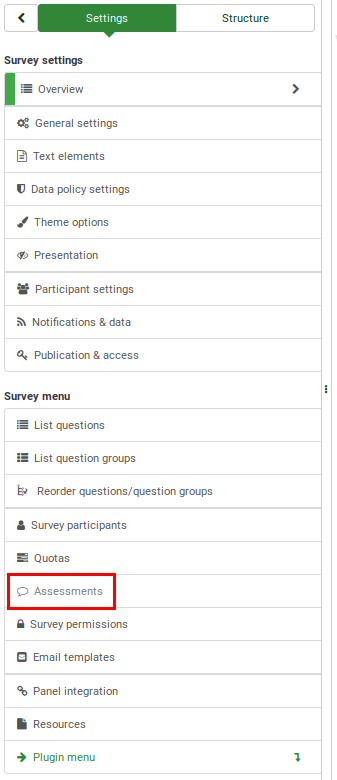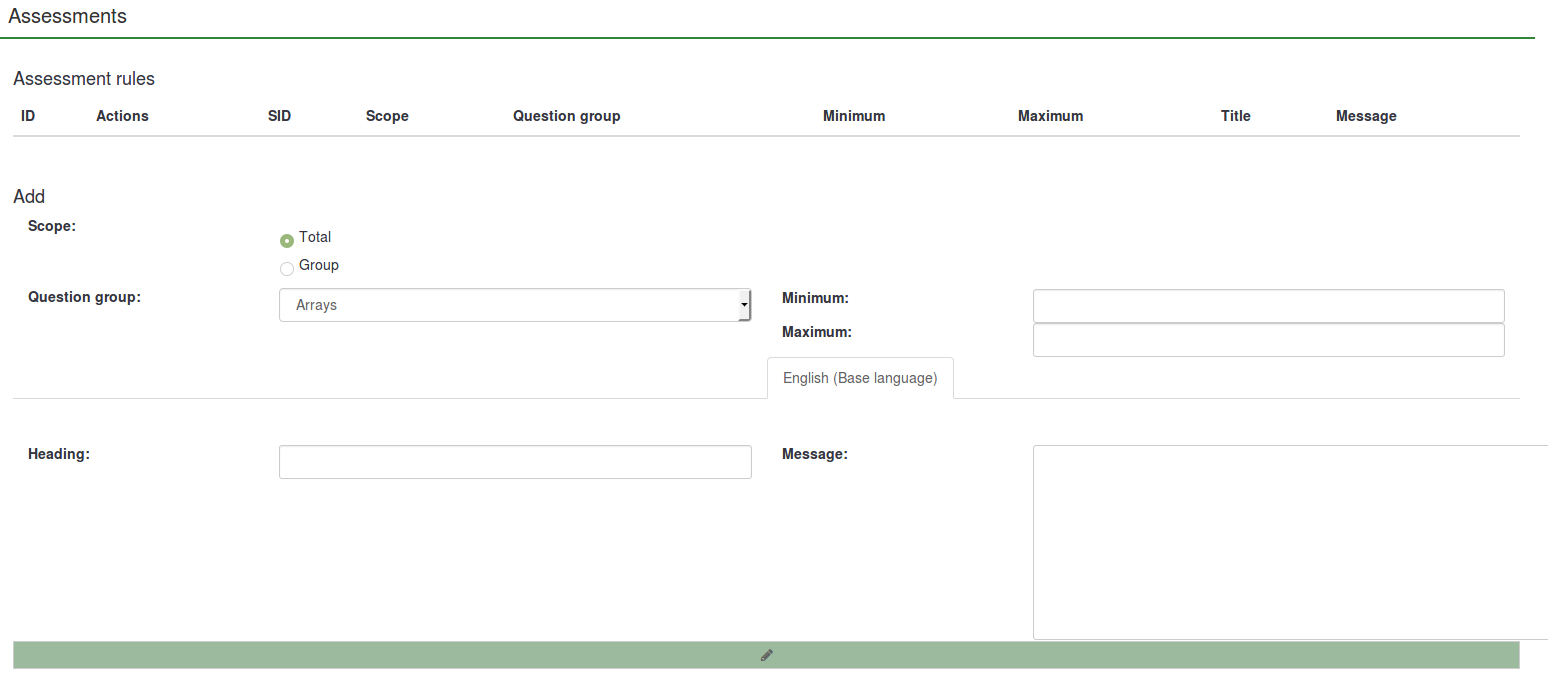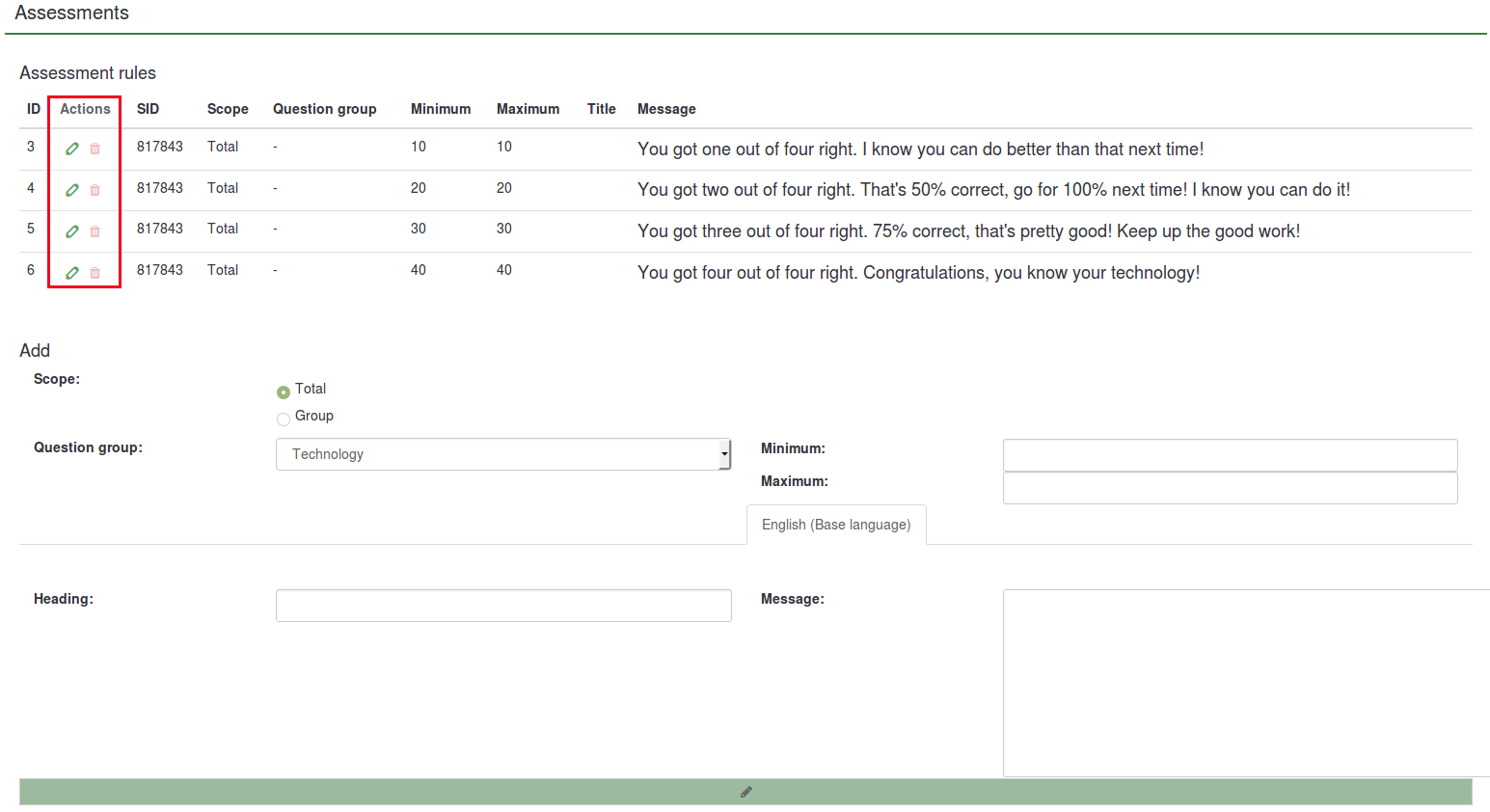Assessments: Difference between revisions
From LimeSurvey Manual
No edit summary |
No edit summary |
||
| Line 5: | Line 5: | ||
<!--T:2--> | <!--T:2--> | ||
<div class="simplebox">[[File:help.png]] '''Hint:''' You can create more sophisticated assessments and reports using the [[Expression Manager|Expression Manager]]. It lets you access all variable types, and easily generate tailored reports at any point in the survey (not just at the end). Using the new ''Equation'' question type, LimeSurvey can automatically save your assessment calculations and/or report to the database.</div> | <div class="simplebox">[[File:help.png]] '''Hint:''' You can create more sophisticated assessments and reports using the [[Expression Manager|Expression Manager]]. It lets you access all variable types, and easily generate tailored reports at any point in the survey (not just at the end). Using the new ''Equation'' question type, LimeSurvey can automatically save your assessment calculations and/or report to the database.</div> | ||
=Introduction= | =Introduction= | ||
| Line 30: | Line 29: | ||
=How do assessments work= | =How do assessments work= | ||
Let's construct a simple example that can help you better understand the way in which the '''assessments mode''' is supposed to work. | |||
<!--T:6--> | <!--T:6--> | ||
Imagine you have two questions in your survey, the first question asks if the user smokes: "Do you smoke?". The question has 3 possible answers, "Yes more than 10 per day" with an answer code of "10", "Yes, but less than 10 per day" with an answer code of "5" and "No, I don't smoke at all" with an answer code of "1". | |||
<!--T:7--> | <!--T:7--> | ||
| Line 53: | Line 52: | ||
To start creating new assessments rules complete | To start creating new assessments rules complete the fields located below the '''Assessment rules''' table. The following options are available: | ||
<!--T:24--> | <!--T:24--> | ||
*Scope: | *Scope: You can choose either ''Total'' or ''Group''. The first will create an assessment based on the sum of all the answers in the entire survey. The latter will create an assessment based on the sum of all the answers from a question group; | ||
*Group: If the scope of | *Group: If you have previously selected ''Group'' as the scope of your assessment, the dropdown list allows you to choose the question group you wish to assess. | ||
*Minimum: The minimum "sum" of answers to which this assessment will apply | |||
*Maximum: The maximum "sum" of answers to which this assessment will apply | {{Box|If you selected ''Total'' before, then the Group field will not influence the assessment of your survey.}} | ||
*Heading: The heading of the assessment which will | *Minimum: The minimum "sum" of answers to which this assessment will apply; | ||
*Message: The actual message for this assessment. Inside the message you can use the tags {PERC} or {TOTAL} to show the related score in that particular message. | *Maximum: The maximum "sum" of answers to which this assessment will apply; | ||
*Heading: The heading of the assessment which will be displayed if the assessment is going to be displayed; | |||
*Message: The actual message for this assessment. Inside the message you can use the tags {PERC} or {TOTAL} to show the related score in that particular message. Click on the green pencil button to access the HTML-editor and enhance the final message of the assessment by adding colours, tables, images, and so on. | |||
<!--T:25--> | <!--T:25--> | ||
You can create as many assessments as you like, and you can create more than one assessment to display for a given score. | You can create as many assessments as you like, and you can create more than one assessment to display for a given score. | ||
After adding some assessments, the possible actions | After adding some assessments, the possible assessments actions will be displayed under the '''Actions''' column of the '''Assessments rules''' table. From there, you can either edit or delete an assessment rule: | ||
<center>[[File:Assessments panel 2.png]]</center> | <center>[[File:Assessments panel 2.png]]</center> | ||
<!--T:26--> | <!--T:26--> | ||
It is important to note that if you use assessments, you must ensure that you have not chosen to autoload the URL at the end of the survey | <div class="simplebox">[[File:help.png]] It is important to note that if you use assessments, you must ensure that you have not chosen to autoload the URL at the end of the survey because the assessments are displayed on the last page of the final "completed" page after submitting a survey. To check whether the autoload URL function is enabled or not, access the '''survey menu''' and then the [[Presentation]] tab.</div> | ||
| Line 81: | Line 79: | ||
<!--T:17--> | <!--T:17--> | ||
There are certain [[question types]] which will not be assessed or will be assessed in a special way. | There are certain [[question types]] which will not be assessed or will be assessed in a special way. Usually, the ones that offer some degree of convenience (having already the answers configured) are not working. However, they can be replaced with assessable question types. For example, a 5 point choice can always be replaced with a simple list (radio) question type. | ||
The following question types '''can be assessed''': | The following question types '''can always be assessed''': | ||
<!--T:18--> | <!--T:18--> | ||
*Array (Flexible labels) dual scale | *Array (Flexible labels) dual scale | ||
| Line 98: | Line 96: | ||
<hr width="50%" style="margin:auto"> | <hr width="50%" style="margin:auto"> | ||
The following list contains question types that '''cannot be assessed''':<!--T:21--> | The following list contains question types that '''cannot be assessed''':<!--T:21--> | ||
| Line 117: | Line 104: | ||
* Array (Multi flexible) (Text) | * Array (Multi flexible) (Text) | ||
* Array (Yes/No/Uncertain) | * Array (Yes/No/Uncertain) | ||
* Array (Multi Flexible) (Numbers) | |||
* Boilerplate question | * Boilerplate question | ||
* Date | * Date | ||
| Line 132: | Line 120: | ||
==Set assessment values for each answer/label== <!--T:13--> | ==Set assessment values for each answer/label== <!--T:13--> | ||
If enabled, the assessment mode will add an additional field between the answer code and answer option name for all the assessable questions: | |||
If enabled, the assessment mode will | |||
<!--T:31--> | <!--T:31--> | ||
<center>[[File:Assesment_value_set.png]]</center> | <center>[[File:Assesment_value_set.png]]</center> | ||
You can also use label sets as answers for your set of questions. Just lick on the '''Predefined label sets...''' button located under the answers matrix and select the desired label set. | |||
If you decide to use label sets, assessment values can be added to all your labels from the moment in which they were firstly created. This allows the survey administrator to quickly use assessed label sets as answers for multiple sets of questions. | |||
<center>[[File:Labels table.png]]</center> | |||
This process is less time-consuming and sometimes it can prove to be quite precise given the fact that you make the plans from the beginning regarding the assessment values of only one set of label sets that it is use for multiple questions rather than creating assessment values for each set of answers for each question. | |||
{{Note|To find out more about the label sets and their usage, read the following [[Labebl sets|wiki section]].}} | |||
| Line 146: | Line 144: | ||
<!--T:28--> | <!--T:28--> | ||
When using assessments the following placeholders are available: | When using assessments the following placeholders are available: | ||
* {PERC}: | * '''{PERC}''': It displays the score of the current group. '''It can be used only in the message field of the assessment rule!''' | ||
* {TOTAL}: | * '''{TOTAL}''': It displays the total score. Only available at assessment message | ||
* {ASSESSMENT_CURRENT_TOTAL}: This placeholder can be used within a survey to display the current total score. Keep in mind that the score is only updated when clicking "next" so this is useless in an all-in-one survey. For now, you must create at least one assessment rule for the placeholder to work. | * '''{ASSESSMENT_CURRENT_TOTAL}''': This placeholder can be used within a survey to display the current total score. Keep in mind that the score is only updated when clicking "next" so this is useless in an ''all-in-one'' survey. For now, you must create at least one assessment rule for the placeholder to work. | ||
| Line 154: | Line 152: | ||
* If you '''only want to use the {ASSESSMENT_CURRENT_TOTAL} placeholder''' within a survey without showing an assessment message at the end of the survey you can: | * If you '''only want to use the {ASSESSMENT_CURRENT_TOTAL} placeholder''' within a survey without showing an assessment message at the end of the survey you can: | ||
** Use an [[Creating_a_new_survey#General|end URL]] and [[Creating_a_new_survey#Presentation_.26_navigation| activate the auto load end URL setting]] for your survey. Then the user will be directly forwarded to the given URL. | ** Use an [[Creating_a_new_survey#General|end URL]] and [[Creating_a_new_survey#Presentation_.26_navigation| activate the auto load end URL setting]] for your survey. Then the user will be directly forwarded to the given URL. | ||
=How to disable the assessments mode= | |||
To deactivate it, go to the '''survey menu''' and look for the '''Data management''' tab. Click on it and the '''Notification and data management panel''' will be displayed. Look for the '''Enable assessment mode''' option and click on it to have it disabled for the respective survey. | |||
<center>[[File:Disable assessment mode - picture.png]]</center> | |||
=Examples= | =Examples= | ||
</translate> | </translate> | ||
Revision as of 17:35, 17 November 2017
Introduction
LimeSurvey contains a feature that allows the survey administrator to create survey "assessments" for his or her respondents - even for multilingual surveys. Assessments are rules which evaluate the responses to a survey immediately after it is submitted, displaying text blocks to the survey participant (based on that evaluation).
In order to use LimeSurvey's assessment feature, access the survey menu and click on the Assessments tab:

Once there, enable the assessment mode:

How do assessments work
Let's construct a simple example that can help you better understand the way in which the assessments mode is supposed to work.
Imagine you have two questions in your survey, the first question asks if the user smokes: "Do you smoke?". The question has 3 possible answers, "Yes more than 10 per day" with an answer code of "10", "Yes, but less than 10 per day" with an answer code of "5" and "No, I don't smoke at all" with an answer code of "1".
The second question "Do you exercise?" has three possible answers; "Yes, I exercise for at least half an hour three times a week" with a value of "1", "Yes, I exercise every now and then" with a value of "5" and "No, I don't ever do any exercise" with an answer code/value of "10".
If we were to add the totals of the values for each possible answer at the end of the survey, we'd have a good indication of the general health of the respondent. Someone who smokes and doesn't ever do any exercises will have scored 10 in each of their answers, giving a sum of 20 when we add the values together. Someone who doesn't smoke and exercises regularly would have scored 1 in each of the answers with a total of 2 when we add the values together.
Assessments
Once enabled, the following page will load up:

To start creating new assessments rules complete the fields located below the Assessment rules table. The following options are available:
- Scope: You can choose either Total or Group. The first will create an assessment based on the sum of all the answers in the entire survey. The latter will create an assessment based on the sum of all the answers from a question group;
- Group: If you have previously selected Group as the scope of your assessment, the dropdown list allows you to choose the question group you wish to assess.
- Minimum: The minimum "sum" of answers to which this assessment will apply;
- Maximum: The maximum "sum" of answers to which this assessment will apply;
- Heading: The heading of the assessment which will be displayed if the assessment is going to be displayed;
- Message: The actual message for this assessment. Inside the message you can use the tags {PERC} or {TOTAL} to show the related score in that particular message. Click on the green pencil button to access the HTML-editor and enhance the final message of the assessment by adding colours, tables, images, and so on.
You can create as many assessments as you like, and you can create more than one assessment to display for a given score.
After adding some assessments, the possible assessments actions will be displayed under the Actions column of the Assessments rules table. From there, you can either edit or delete an assessment rule:

How question types are evaluated
There are certain question types which will not be assessed or will be assessed in a special way. Usually, the ones that offer some degree of convenience (having already the answers configured) are not working. However, they can be replaced with assessable question types. For example, a 5 point choice can always be replaced with a simple list (radio) question type.
The following question types can always be assessed:
- Array (Flexible labels) dual scale
- Array (Flexible labels)
- Array (Flexible labels) by column
- List (Flexible labels) (Dropdown)
- List (Flexible labels) (Radio)
- List (Dropdown)
- List (Radio)
- List with comment
- Multiple options
- Multiple options with comments
The following list contains question types that cannot be assessed:
- 5 point choice
- Array (5 point choice)
- Array (10 point choice)
- Array (Increase, Same, Decrease)
- Array (Multi flexible) (Text)
- Array (Yes/No/Uncertain)
- Array (Multi Flexible) (Numbers)
- Boilerplate question
- Date
- Gender
- Huge free text
- Language switch
- Long free text
- Multiple numerical input
- Numerical input
- Ranking
- Short free text
- Yes/No
Set assessment values for each answer/label
If enabled, the assessment mode will add an additional field between the answer code and answer option name for all the assessable questions:

You can also use label sets as answers for your set of questions. Just lick on the Predefined label sets... button located under the answers matrix and select the desired label set.
If you decide to use label sets, assessment values can be added to all your labels from the moment in which they were firstly created. This allows the survey administrator to quickly use assessed label sets as answers for multiple sets of questions.

This process is less time-consuming and sometimes it can prove to be quite precise given the fact that you make the plans from the beginning regarding the assessment values of only one set of label sets that it is use for multiple questions rather than creating assessment values for each set of answers for each question.
Assessment placeholders
When using assessments the following placeholders are available:
- {PERC}: It displays the score of the current group. It can be used only in the message field of the assessment rule!
- {TOTAL}: It displays the total score. Only available at assessment message
- {ASSESSMENT_CURRENT_TOTAL}: This placeholder can be used within a survey to display the current total score. Keep in mind that the score is only updated when clicking "next" so this is useless in an all-in-one survey. For now, you must create at least one assessment rule for the placeholder to work.
Tips & tricks
- If you only want to use the {ASSESSMENT_CURRENT_TOTAL} placeholder within a survey without showing an assessment message at the end of the survey you can:
- Use an end URL and activate the auto load end URL setting for your survey. Then the user will be directly forwarded to the given URL.
How to disable the assessments mode
To deactivate it, go to the survey menu and look for the Data management tab. Click on it and the Notification and data management panel will be displayed. Look for the Enable assessment mode option and click on it to have it disabled for the respective survey.
